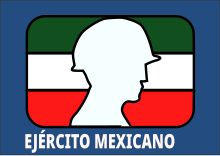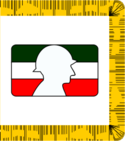Mexican army
| Mexican Army Ejército Mexicano |
|
|---|---|

Mexican Army emblem
|
|
| Active | February 19, 1913 – present |
| Country |
|
| Branch |
|
| Type | Army and air force |
| Size | Active: 700,000 + (2016), 300,000 + plus reservists of the National Military Service (2015 est.) |
| Part of |
Secretariat of National Defense Mexican Armed Forces |
| Motto(s) | Siempre Leales (Always Loyal) |
| Mascot(s) | Golden eagle |
| Anniversaries |
February 19, Day of the Army. |
| Equipment | See: Equipment |
| Engagements |
War of Independence Spanish attempts to reconquer Mexico Texas Revolution Pastry War Capture of Monterey Mexican–American War Caste War of Yucatán Reform War French Intervention Mexican Revolution Border War Cristero War World War II Dirty War Zapatista Uprising Mexican Drug War |
| Insignia | |
| Guidon |  |
| Flag (unofficial) |  |
February 19, Day of the Army.
The Mexican Army (Spanish: Ejército Mexicano) is the combined land and air branch and largest of the Mexican Armed Forces; it is also known as the National Defense Army.
It was the first army to adopt (1908) and use (1910) a self-loading rifle, the Mondragón rifle. The Mexican Army has an active duty force of 766,750 (2015 est.).
Mexico has no major foreign nation-state adversaries. It officially repudiates the use of force to settle disputes and rejects interference by one nation in the affairs of another. Although it has not suffered a major international terrorist incident in recent decades, the Mexican government considers the country a potential target for international terrorism.
In the prehispanic era, there were many indigenous tribes and highly developed city-states in what is now known as central Mexico. The most advanced and powerful kingdoms were those of Tenochtitlan, Texcoco and Tlacopan, which comprised populations of the same ethnic origin and were politically linked by an alliance known as the Triple Alliance; colloquially these three states are known as the Aztec. They had a center for higher education called the Calmecac in Nahuatl, this was where the children of the Aztec priesthood and nobility receive rigorous religious and military training and conveyed the highest knowledge such as: doctrines, divine songs, the science of interpreting codices, calendar skills, memorization of texts, etc. In Aztec society, it was compulsory for all young males, nobles as well as commoners, to join part of the armed forces at the age of 15.
Itzcoatl "Obsidian Serpent" (1381–1440), fourth king of Tenochtitlán, organized the army that defeated the Tepanec of Atzcapotzalco, freeing his people from their dominion. His reign began with the rise of what would become the largest empire in Mesoamerica. Then Moctezuma Ilhuicamina "The arrow to the sky" (1440–1469) came to extend the domain and the influence of the monarchy of Tenochtitlán. He began to organize trade to the outside regions of the Valley of Mexico. This was the Mexica ruler who organized the alliance with the lordships of Texcoco and Tlacopan to form the Triple Alliance.
...
Wikipedia
